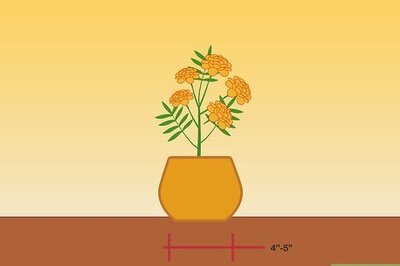
views
Washington: Inter-personal violence, infectious diseases and climate change had played a major role in the demise of the Indus or Harappan civilisation around 4,000 years ago, according to a new study.
Climate, economic and social changes all played a role in the process of urbanisation and collapse, but little was known about how these changes affected the human population, Dr Gwen Robbins Schug, an associate professor of anthropology at Appalachian State University in North Carolina, explained in a statement.
"The collapse of the Indus Civilisation and the reorganisation of its human population has been controversial for a long time," Schug said, who is the lead author of a paper, published in the journal PLOS ONE.
Schug and an international team of researchers examined evidence for trauma and infectious disease in the human skeletal remains from three burial areas at Harappa, one of the largest cities in the Indus Civilization, the University said in a media release.
The results of their analysis counter longstanding claims that the Indus civilization developed as a peaceful, cooperative, and egalitarian state-level society, without social differentiation, hierarchy, or differences in access to basic resources, it said.
The data suggest instead that some communities at Harappa faced more significant impacts than others from climate and socio-economic strains, particularly the socially disadvantaged or marginalized communities who are most vulnerable to violence and disease.
This pattern is expected in strongly socially differentiated, hierarchical but weakly controlled societies facing resource stress, the university said, adding that, the study add to the growing body of research about the character of Indus society and the nature of its collapse.
"Early research had proposed that ecological factors were the cause of the demise, but there wasn't much paleoenvironmental evidence to confirm those theories. In the past few decades, there have been refinements to the available techniques for reconstructing paleoenvironments and burgeoning interest in this field," she said.
"Rapid climate change events have wide-ranging impacts on human communities. Scientists cannot make assumptions that climate changes will always equate to violence and disease," Schug said.
"However, in this case, it appears that the rapid urbanisation process in Indus cities, and the increasingly large amount of culture contact, brought new challenges to the human population. Infectious diseases like leprosy and tuberculosis were probably transmitted across an interaction sphere that spanned Middle and South Asia," Schug said.
Schug's research shows that leprosy appeared at Harappa during the urban phase of the Indus Civilisation, and its prevalence significantly increased through time. New diseases, such as tuberculosis, also appear in the Late Harappan or post-urban phase burials, she said.
Violent injury such as cranial trauma also increases through time, a finding that is remarkable, she said, given that evidence for violence is very rare in prehistoric South Asian sites generally, Schug said.
"As the environment changed, the exchange network became increasingly incoherent. When you combine that with social changes and this particular cultural context, it all worked together to create a situation that became untenable," she said.
The results of the study are striking, according to Schug, because violence and disease increased through time, with the highest rates found as the human population was abandoning the cities.
However, an even more interesting result is that individuals who were excluded from the city's formal cemeteries had the highest rates of violence and disease, she said.
In a small ossuary southeast of the city, men, women, and children were interred in a small pit. The rate of violence in this sample was 50 per cent for the 10 crania preserved, and more than 20 per cent of these individuals demonstrated evidence of infection with leprosy.
Schug said lessons from the Indus Civilization are applicable to modern societies too.
"Human populations in semi-arid regions of the world, including South Asia, currently face disproportionate impacts from global climate change," the researchers wrote.


















Comments
0 comment